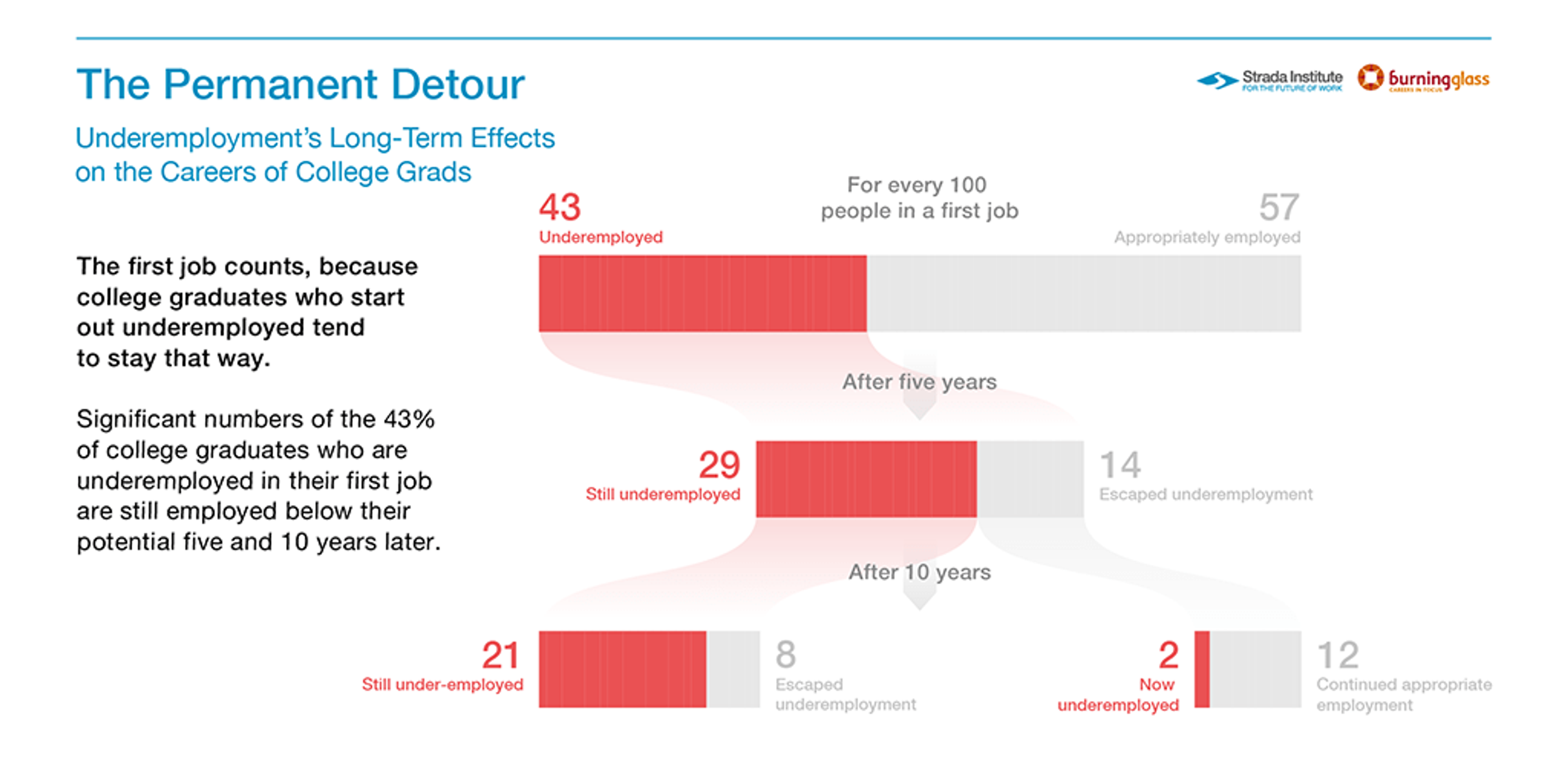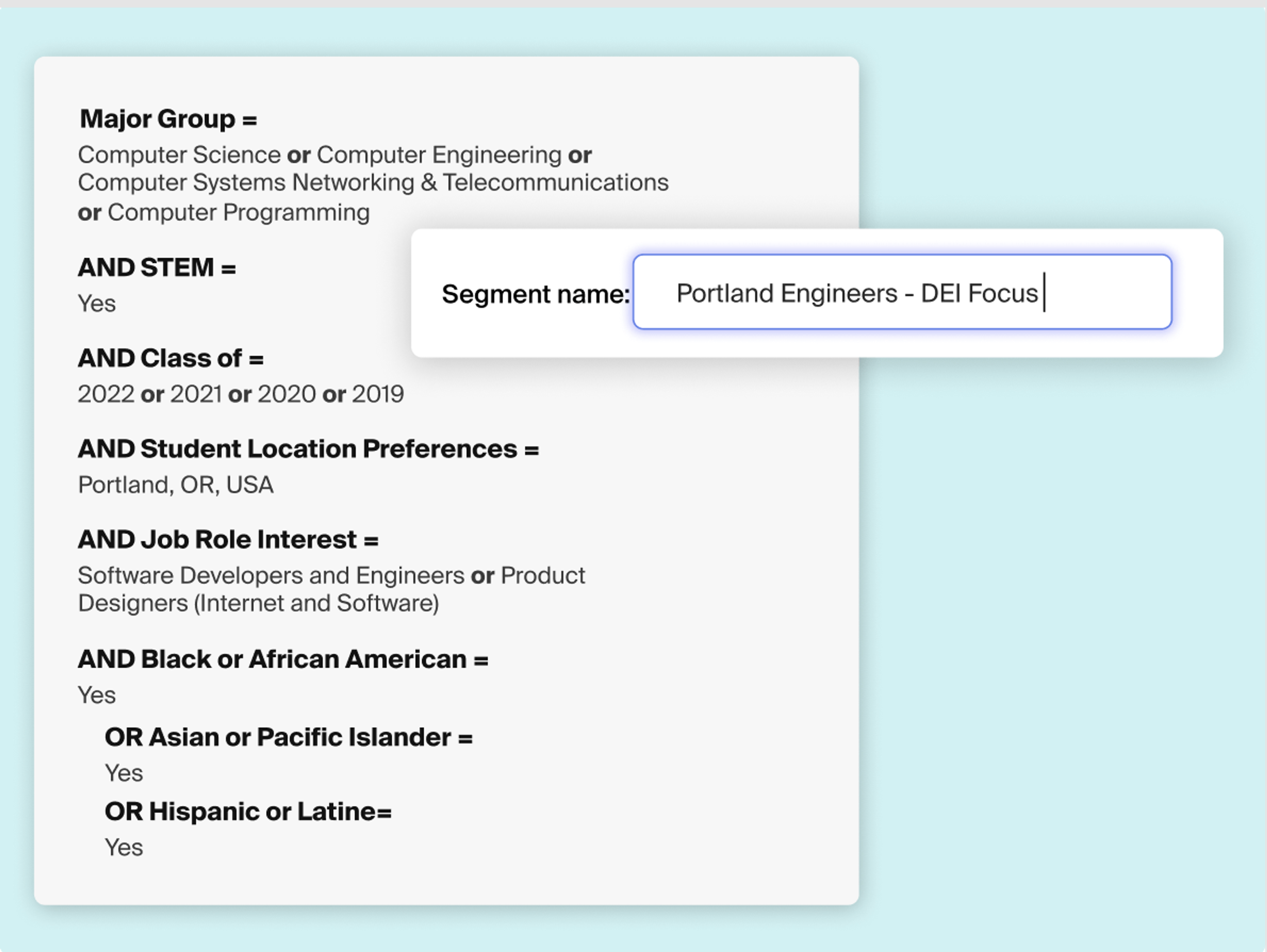Diversity, equity, and inclusion (DEI) has been a familiar concept for decades, but the cataclysm of events of 2020 finally made human resources departments and leadership teams play a more active role.
The murders of Breonna Taylor and George Floyd at the hands of police became watershed moments, inspiring action on justice and reform.
Employers across the country examined their own role in opening or closing career access to underrepresented groups. Were their hiring practices contributing to a system that denied access to certain candidates?
For Gen Z, these answers are critical: nearly 3 in 5 say they want to know an employer’s stance on social justice before applying to a job.
As the largest network serving both the needs of Gen Zers who are just starting out in their careers and the needs of employers looking to fill internship and entry-level roles, Handshake found itself in a position to transform early career outcomes.
Corporate America unpacks its diversity problem

From a report by Strada-Burning Glass titled "The Permanent Detour: Underemployment’s Long-term Effects on the Careers of College Graduates"
Studies show that the average college graduate earns $1 million more during the course of their career than those with a high school diploma.
It’s clear that a degree, certification, or professional credential is almost a requirement for upward mobility, but considering that 43% of graduates start out underemployed—and half stay that way 10 years later—why is that mobility not translating across all segments of the population?
After all, Gen Z is the most highly educated and ethnically diverse of all generations. The data shows that diversity in corporate America isn’t a pipeline problem; it's that candidates are still not competing on a leveled playing field due to obstacles that have become entrenched in corporate bureaucracy.
And over the years, inefficient recruiting practices have only contributed to inequity and pipeline homogeneity.
For example, the “core schools” approach traditionally utilized by many top companies—where they engage students at only the most selective schools or schools their leadership team attended—has not only created a situation where everyone is competing for the same few, but has also led to a one-dimensional workforce and perpetuated systems of hiring bias.
Handshake was founded on the belief that a new approach to recruiting can be part of the solution.
Handshake’s role in expanding access to opportunity
Before Handshake, there wasn’t a single recruiting platform for distributed access or a centralized place for employer-student relationships to occur. The antiquated early talent recruiting process involved a lot of manual work, like posting jobs individually to partner schools and spending time traveling to meet with students at select campuses.
Over 2.8M women, 600k Black, 750k Asian, and 650k Hispanic or Latine candidates rely on Handshake to build professional relationships and launch careers.
As Gen Z began to insist on changes to the old and outdated ways of entering the workforce, Handshake’s all-in-one virtual recruiting platform met the new demand and helped to facilitate access and unlock job opportunities to a wider range of candidates, supporting 15M+ active college students and recent graduates in their early career search.
~1M employers, including all of the Fortune 500, rely on Handshake to recruit remarkable candidates from 1,500+ higher education institutions nationwide, including more than 180 minority-serving institutions (MSIs) and 82% of the top 50 Historically Black Colleges and Universities (HBCUs).
Handshake’s vision for the future: Putting students first with self-identification
In 2020, Handshake introduced Self-Identification, a new feature for early career job seekers to self-identify their gender or pronouns, which more than 3.3M students have already opted in to do, and their race or ethnicity, which more than 2M students have already opted in to do.
Before making any self-identification updates to our product, we conducted thorough research to better understand student perceptions on sharing personal information such as their race and ethnicity and their expectations for how this information should be used.
We also wanted to determine the best way to ask for this information that would be inclusive and equitable, and went to great lengths to ensure our self-identification process was designed with student preferences in mind.
Querying a diverse participant pool in our research, we uncovered a number of ways that Gen Zers prefer to be self-identified:
- To be hired based on skills and qualifications
- To understand how demographic information is used
- Not to be “tokenized” to satisfy a diversity requirement
- For race not to be a qualifying factor in a hiring decision
- Transparency on how they’re identified; no assumptions
- To work for a company that values DEI
Put these learnings into practice:
Learn how to craft effective messages that resonate with underrepresented students without tokenizing them and be more intentional in your outreach by adopting inclusive language.
It is important to note that self-identification information is anonymized and aggregated across groups of students. It is not a data point that shows up on a student’s individual profile as the intent of the feature is for employers who want to cast a wider net to be able to add a layer onto their search.
For example, let’s say you’re seeking candidates with a preference of working in Portland, OR and have a background in computer science. Let’s also say that you’re keen on hiring Black talent to balance a lack of representation.
You can now add ‘Black or African American’ as a secondary layer to your Student Search.

Handshake Premium's Segments give employers the ability to find qualified candidates that match their criteria, including students who have self-identified their gender, pronouns, race, or ethnicity.
The addition of self-identification is just one way that employers can use specific criteria in their targeted outreach and create more access to job opportunities for everyone.
Students on Handshake can opt in to self-identify their gender, pronouns, race, and/or ethnicity, and indicate their preference to work for employers committed to increasing representation.
Handshake Premium employer partners are able to source and engage students that have self-identified their gender and ethnicity through Segments.
Handshake’s commitment to recruiting for diversity, equity, and inclusion
Handshake’s network is expanding every day to include more students from different backgrounds, interests, schools, and locations. And we are actively diversifying our portfolio of partner institutions by adding more community colleges, technical schools, trade schools, bootcamps, and MSIs to our network.
There are a number of ways for employers to actively seek out underrepresented groups on the platform and gain visibility into student attendance at MSIs, HBCUs, trade schools, and community colleges, as well as membership in student organizations.
Handshake’s School Recommendations and School Explorer can help employers with real-time suggestions for new school partners based on qualifiers. Employers can lean on these tools to connect with schools that house large populations of underrepresented candidates and post an unlimited number of jobs to multiple schools at the same time, becoming inherently more inclusive by allowing any student to apply.
From there, employers can proactively identify and drill down their qualified candidate base by leaning on 19 attributes—like major, skillset, location, student organization, and self-identified gender and ethnicity—to message and connect with priority talent at these schools using Handshake Premium’s Segments and Campaigns.
On Handshake, employers can create a branded page to feature media, candidate reviews, employee testimonials, and job posts with custom branding that highlight their values to students from all backgrounds. Employers can also make their brand or alumni ambassadors available to candidates, facilitate these connections, and nurture strong relationships based on background or shared experiences.

With transparent employee perspectives, featured jobs, interview Q&A, and rich media like videos, Employer Pages on Handshake empower employers to put their best foot forward.
"When it comes to achieving our DEI goals, Handshake has been a great resource for us, allowing us to reach such a wide and diverse audience. The messaging campaigns and virtual events, specifically, have been very helpful." - Chelsea Littleton (Russo), Director of Talent Acquisition and Development at Webber
Virtual recruiting lays the groundwork for a more equitable future
In addition to advanced planning, staffing, and allocation of resources, in-person recruiting events confined an employers’ reach and traditionally appealed to a limited number of students—typically the most confident and network-established—often leaving out those who may be juggling coursework with other commitments, like part-time jobs.
The shift to virtual recruiting that took place during the beginning of the pandemic required employers to adopt new strategies to engage students, resulting in wider reach to groups that have historically faced hiring bias.
3 in 5 Black and Hispanic or Latine students say they’re more likely to apply to a job after attending a virtual career event, according to a Handshake report.
In the seasons since, virtual events have been found to decrease recruiting marginalization: women and students of color report more confidence and less competition with virtual events when compared to in person.
And every 3 in 5 Black and Hispanic/Latine students say they learn more about an employer through a virtual interaction, and are more likely to apply to a job with that employer as a result.
Employers are responding accordingly, with 71% sharing that they’ve increased virtual recruiting to engage more marginalized students and dozens already pledging to prioritize a digital-first strategy to transform the makeup of their workforce.
Handshake helps employers recruit from populations they may have historically missed. GE, for example, leans on the platform to execute a far-reaching virtual event strategy, double its student reach, and meet lofty gender and racial diversity hiring goals.
With partnership comes progress
We’ll continue to invest in virtual and other technologies that reduce selection biases and application barriers to make the hiring process more inclusive, and build on features that help employers optimize and personalize the candidate experience.
We are encouraged by the early results we’re seeing in the industry.
In 2021, HBCUs on Handshake witnessed a 73% increase in the number of employer-hosted events. And going forward, nearly 8 in 10 companies say that they are planning to allocate more budget to diversity, equity, and inclusion (DEI) in 2022. As a result of all of this activity:
- EY sees 125% increase in job and event engagement from Black/Latine candidates
- 80% of Uncommon Schools’ Summer Teaching Fellows identify as people of color
- Kraft Heinz receives 2.3x more Black, 1.8x more Latine, and 19% more women applicants than competitors in their industry
These numbers give us reason to be optimistic.
Our vision is a world in which there is opportunity for all to fulfill their career aspirations, regardless of where they’re from or who they know. Handshake is committed to working in partnership with schools and employers to rethink DEI recruiting and make the experience more equitable for all involved, and for the present and future generations of early career job seekers.
About Handshake
Thanks to the size of its network and all-in-one engagement tools, Handshake provides employers with the resources they need to pursue a more inclusive hiring process and a representative talent pool. It’s the leading platform that facilitates how college students and recent graduates network, build relationships, and find meaningful jobs, in turn impacting how employers recruit for DEI and diversify their teams.
